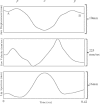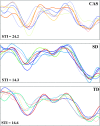Oral Articulatory Control in Childhood Apraxia of Speech
- PMID: 25951237
- PMCID: PMC4540646
- DOI: 10.1044/2015_JSLHR-S-13-0221
Oral Articulatory Control in Childhood Apraxia of Speech
Abstract
Purpose: The purpose of this research was to examine spatial and temporal aspects of articulatory control in children with childhood apraxia of speech (CAS), children with speech delay characterized by an articulation/phonological impairment (SD), and controls with typical development (TD) during speech tasks that increased in word length.
Method: The participants included 33 children (11 CAS, 11 SD, and 11 TD) between 3 and 7 years of age. A motion capture system was used to track jaw, lower lip, and upper lip movement during a naming task. Movement duration, velocity, displacement, and variability were measured from accurate word productions.
Results: Movement variability was significantly higher in the children with CAS compared with participants in the SD and TD groups. Differences in temporal control were seen between both groups of children with speech impairment and the controls with TD during accurate word productions. As word length increased, movement duration and variability differed between the children with CAS and those with SD.
Conclusions: These findings provide evidence that movement variability distinguishes children with CAS from speakers with SD. Kinematic differences between the participants with CAS and those with SD suggest that these groups respond differently to linguistic challenges.
Figures





Similar articles
-
Articulatory Control in Childhood Apraxia of Speech in a Novel Word-Learning Task.J Speech Lang Hear Res. 2016 Dec 1;59(6):1253-1268. doi: 10.1044/2016_JSLHR-S-14-0261. J Speech Lang Hear Res. 2016. PMID: 27750297 Free PMC article.
-
Lexical stress in childhood apraxia of speech: acoustic and kinematic findings.Int J Speech Lang Pathol. 2020 Feb;22(1):12-23. doi: 10.1080/17549507.2019.1568571. Epub 2019 Feb 11. Int J Speech Lang Pathol. 2020. PMID: 30744428 Free PMC article.
-
Changes in movement transitions across a practice period in childhood apraxia of speech.Clin Linguist Phon. 2018;32(7):661-687. doi: 10.1080/02699206.2017.1419378. Epub 2017 Dec 27. Clin Linguist Phon. 2018. PMID: 29281317 Free PMC article.
-
Tools for the assessment of childhood apraxia of speech.Codas. 2015 Nov-Dec;27(6):610-5. doi: 10.1590/2317-1782/20152014152. Codas. 2015. PMID: 26691627 Review. English, Portuguese.
-
Childhood speech apraxia in focus: theoretical perspectives and present tendencies.Pro Fono. 2009 Jan-Mar;21(1):76-80. Pro Fono. 2009. PMID: 19360263 Review.
Cited by
-
Articulatory Control in Childhood Apraxia of Speech in a Novel Word-Learning Task.J Speech Lang Hear Res. 2016 Dec 1;59(6):1253-1268. doi: 10.1044/2016_JSLHR-S-14-0261. J Speech Lang Hear Res. 2016. PMID: 27750297 Free PMC article.
-
Vowel Accuracy and Segmental Variability Differentiate Children With Developmental Language Disorder in Nonword Repetition.J Speech Lang Hear Res. 2020 Dec 14;63(12):3945-3960. doi: 10.1044/2020_JSLHR-20-00166. Epub 2020 Nov 17. J Speech Lang Hear Res. 2020. PMID: 33201753 Free PMC article.
-
Articulatory and segmental performance in children with and without speech disorder: A multiple case pilot study.Clin Linguist Phon. 2023 Oct 3;37(10):935-957. doi: 10.1080/02699206.2022.2108724. Epub 2022 Aug 16. Clin Linguist Phon. 2023. PMID: 35971981 Free PMC article.
-
Speech-Language Pathologists' Ratings of Speech Accuracy in Children With Speech Sound Disorders.Am J Speech Lang Pathol. 2022 Jan 18;31(1):419-430. doi: 10.1044/2021_AJSLP-20-00381. Epub 2021 Nov 17. Am J Speech Lang Pathol. 2022. PMID: 34788553 Free PMC article.
-
A Diagnostic Marker to Discriminate Childhood Apraxia of Speech From Speech Delay: I. Development and Description of the Pause Marker.J Speech Lang Hear Res. 2017 Apr 14;60(4):S1096-S1117. doi: 10.1044/2016_JSLHR-S-15-0296. J Speech Lang Hear Res. 2017. PMID: 28384779 Free PMC article. Review.
References
-
- American Speech-Language-Hearing Association. (2007). Childhood apraxia of speech [Technical report]. Available from http://www.asha.org/policy
-
- Bahr R. H. (2005). Differential diagnosis of severe speech disorders using speech gestures. Topics in Language Disorders, 25, 254–265.
-
- Burgmeister B., Blum L., & Lorge I. (1972). Columbia Mental Maturity Scale. San Antonio, TX: Psychological Corporation.
-
- Case J., Moss A., & Grigos M. I. (2012, November). Measuring error consistency in children with apraxia of speech. Poster presented at the Annual Convention of the American Speech-Language-Hearing Association, Atlanta, GA.
-
- Estrem T., & Broen P. A. (1989). Early speech productions of children with cleft palate. Journal of Speech, Language, and Hearing Research, 32, 12–23. - PubMed
Publication types
MeSH terms
Grants and funding
LinkOut - more resources
Full Text Sources
Medical
Research Materials

